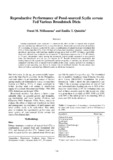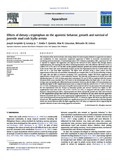The effects of diets on reproductive performance of eyestalk ablated and intact mud crab Scylla serrata
- Global styles
- MLA
- Vancouver
- Elsevier - Harvard
- APA
- Help

View/
Date
2000Page views
2,692ASFA keyword
AGROVOC keyword
Taxonomic term
Metadata
Show full item record
Share
Abstract
The reproductive performance of female mud crabs was evaluated as affected by various diets. Dietary treatments were as follows: D1 — natural diet (mussel meat, squid, trash fish); D2 — combination of natural and formulated diets; D3 — formulated diet. Pond-sourced broodstock, with initial body weight of 300–400 g, were tagged in their carapace then stocked in three units of 10 m3 broodstock tanks at eight females per tank. Half of the females were ablated and the other half were intact. Spawnings were monitored and berried females were transferred to individual 500-l tanks for incubation of eggs. Four experimental runs were conducted. Broodstock response in terms of number of spawnings, spawnings with hatching, fecundity, egg fertilization rate, total zoea produced and broodstock survival was enhanced in females fed the mixed diet (D2) compared to those fed the natural diet (D1) or the formulated diet (D3). Larval quality measured as larval stage index followed the same trend. Results further showed that intact females fed diets D1 and D2 gave higher numerical values in reproductive performance and zoea growth index than ablated females while ablated females fed diet D3 performed better than their intact counterparts. This may be attributed to presence of essential nutrients and vitamins A, C, E in the formulated diet. Latent period from gonadal maturation to first spawning was shortened by eyestalk ablation. Use of a combined diet would ensure the production of good quality eggs and large numbers of zoea with the best chance of completing the larval stages and thus, would serve as an appropriate starting point in establishing a viable mud crab aquaculture.
Suggested Citation
Millamena, O. M., & Quinitio, E. (2000). The effects of diets on reproductive performance of eyestalk ablated and intact mud crab Scylla serrata. Aquaculture , 181(1-2), 81-90. https://doi.org/10.1016/S0044-8486(99)00214-8
Type
ArticleISSN
0044-8486Collections
- Journal Articles [1256]
Related items
Showing items related by title, author, creator and subject.
-
Reproductive performance of pond-sourced Scylla serrata fed various broodstock diets
Millamena, Oseni M.; Quinitio, Emilia T. (Australian Centre for International Agricultural Research, 1999)
Feeding experiments were conducted to determine the effect of diet on reproduction of pond-sourced unablated and ablated Scylla serrrata broodstock. Broodstock were fed either natural food (T1) consisting of mussel, squid, ...
(Australian Centre for International Agricultural Research, 1999)
Feeding experiments were conducted to determine the effect of diet on reproduction of pond-sourced unablated and ablated Scylla serrrata broodstock. Broodstock were fed either natural food (T1) consisting of mussel, squid, ... -
Effects of dietary l-tryptophan on the agonistic behavior, growth and survival of juvenile mud crab Scylla serrata
Laranja, Joseph Leopoldo Q., Jr.; Quinitio, Emilia T. ; Catacutan, Mae R.; Coloso, Relicardo M. (Elsevier, 2010)
The reduction of the survival of mud crab during culture has been largely attributed to aggressive encounters and cannibalism. In some crustaceans, suppressed aggression is linked to increased concentration of circulating ...
; Catacutan, Mae R.; Coloso, Relicardo M. (Elsevier, 2010)
The reduction of the survival of mud crab during culture has been largely attributed to aggressive encounters and cannibalism. In some crustaceans, suppressed aggression is linked to increased concentration of circulating ... -
Pond culture of mud crab Scylla serrata (Forskal) fed formulated diet with or without vitamin and mineral supplements
Triño, Avelino T.; Millamena, Oseni M.; Keenan, C. P. (Asian Fisheries Society, 2001)The effects of three diets (Diet 1 – with vitamin and mineral supplements, Diet 2 – without vitamin and mineral supplements, and Diet 3 – fish bycatch) and monosex culture (male or female) on the growth, survival, feed ...





